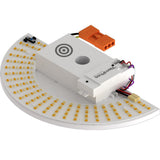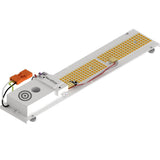Zhaga Consortium - A New Shape and Name for the Light Bulb?
Posted by Dave on for ProLampSales

Ever since Thomas Edison's early light bulbs, the iconic shape of the most common light bulb in our homes has been remarkably consistent - pear-shaped glass narrowing to a screw base at one end. This shape is so ingrained in our collective consciousness that it has become a cliche graphic used in endless ways to represent a bright idea, a sudden revelation, or all of artificial lighting in general.
Over the last 100 years new lighting technologies expanded the repertoire of shapes. Fluorescent gave us the long tube. Halogen introduced the small capsule with an assortment of pins and other types of electrical contacts at the base. Metal halide took the pear shape and stretched it into a bulbous shape.
Now we are at the beginning of the LED age. Although solid state LED is the most radically different lighting technology since Edison, what we are seeing at the dawn of this new era of lighting, is the LED packaged in the same shapes of the incandescent, halogen, fluorescent, and HID bulbs. Even if these shapes do not take optimum advantage of the LED technology, they are the only way to create a retrofit LED inventory of bulbs for direct replacement into existing sockets.
In the next 100 years, probably sooner, the LED lighting revolution will also mean a completely new world of shapes that contain the LEDs. The word "light bulb," may even disappear from the lexicon. Even now, LEDs are available in flexible strips and ropes, ultraviolet LEDs for curing, masses of lights that look like blobs for holiday decoration, and LEDs with integrated features like motion control or microphones.
Zhaga sounds like a video game company, but it's actually a consortium of lighting manufacturers working together to develop a new "light bulb" and, in the process, a new way of talking about the object found in fixtures that produce light.
In brief, the mission of the Zhaga Consortium is to identify optimal LED light engine form factors (the LED module and the driver) for different light fixture types. For example, a recessed downlight fixture allows for a different optimal shape and light distribution than a track light fixture. Zhaga calls these new shapes "interfaces". LED light engines that are Zhaga compliant do not use sockets in the way as virtually all light bulbs today. Instead Zhaga defines an interface specification connecting the LED light engine to the fixture.
To date, at least ten different interface specifications have been developed. These are the new "light bulb" shapes that may be found in the light fixtures of the future.
Already Signify, Ledvance, Regent Lighting, and many others have become members of the consortium. The first interfaces that are being used in new fixtures designed specifically to use Zhaga-certified light engines. At the most recent Lightfair International, commercially available fixtures equipped with light engines, not "light bulbs" were on display. It will take years, but eventually most light fixtures will be sold with these Zhaga compliant light engines. After that, the word "light bulb" will become a memory along with the pear shape and screw base from the first age of electric lighting.
- Posted in LED
Featured Products (View All)
0 Comments




